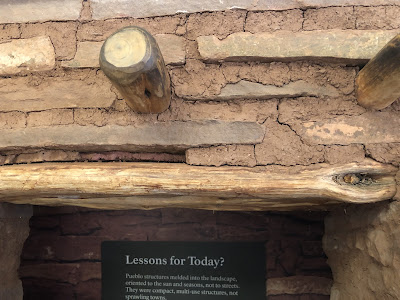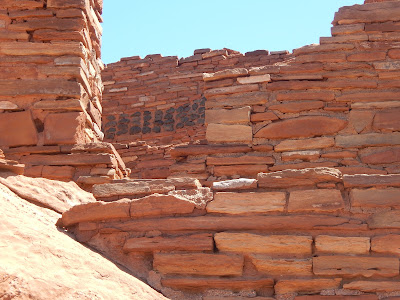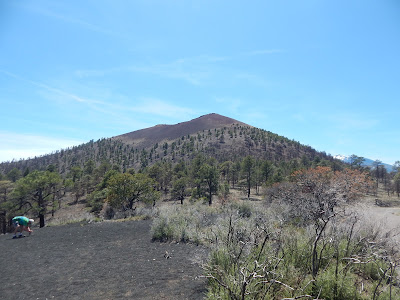This first set of ruins are located in a box canyon. Early inhabitants constructed walk if nearby sandstone and limestone and used local soils to cement the stones together. The flat roofs were built of timbers laid side by side, covered with smaller branches and finally plastered over with mud.
This is a close up of the soil that they used for grout to stick everything together.
Doorways were small and windows almost non-existent. As the rooms ere abandoned, the Timbers were often scavenged and used in other Puebla’s or burned for firewood, a precious commodity in this environment. The park service has stabilized these 800 year old walls to help preserve them but none were reconstructed. The walls are just has they were when they were discovered.
The visitor centre is located at Wupatki Puebla. What started out as family housing grew into this 100 room pueblo with a tower, community room and ceremonial ball court. Located near the crossroads of eas-west and north-south travel routes. This pueblo evolved to serve a community heavily engaged not only in farming but also in ceremony, trade and crafts. by 1190 as many as 2,000 people lived within a day’s walk. This was the largest building within 50 miles.
The people of the area were mainly farmers. They had to rely on special farming techniques to grow their crops in this dry, hot climate. This area received only 11 inches of rain fall on average each year. They harvested rainfall and storm small springs and seeps, but those have mainly dried up now.
This is an example of a garden that would have been planted, they used the mulch that came from the volcanic ash from the Sunset Crater Volcano. The native men would stay with the crops all summer as they did not have fences to keep animals out. Here is an example of the corn that they would have grown.
This is what is left of the pueblo. The National parks service have fortified the walls and have done and excellent job of maintaining what has remained. You can picture a booming town center with people trading and celebrating.
The wind is a powerful erosion tool, it creates these unique designs in the rock
This monument actually has two section that are linked together, after the pueblo you start to drive through the Sunset Crater part of the park. Sunset Volcano is a nearly symmetrical cinder cone formed in the mid 1080’s. This type of volcano differs from a Stratovolcano like Mount St Helens. When it erupted is covered 64,000 acres of farmland. They estimate that the ash cloud, rose over 2.5 miles high and was visible across most of present day Arizona, New Mexico and parts of Utah.
Lava broke out of the base and flowed for many miles, you can still see the remnants.
On April 19, 2022 a wind driven wildfire named the tunnel fire swept through the park and burned 61% of the area and grew to almost 20,000 acres in 48 hours. Luckily there was not loss of life. You can see that the land has started to recover and large areas of grass and wildflowers are thriving. Here is an example of rabbit brush.
Sunset crater’s otherworldly landscape provide the perfect place to train for NASA;s Apollo Moon program. Astronauts practiced collecting rock samples and setting up scientific instruments, mapping terrain and taking scientifically useful photos. They learned to look closely at the volcanic landscape to compare it with similar features on the moon.

















No comments:
Post a Comment